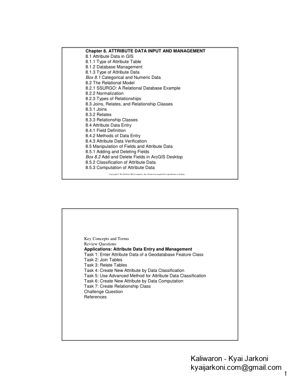These attributes include street name, address ranges on the left side and the right side, as well as ZIP codes on both sides. Page 3. 3. Feature Attribute Table.
13 pages
65 KB – 13 Pages
PAGE – 1 ============
1Chapter 8. ATTRIBUTE DATA INPUT AND MANAGEMENT 8.1 Attribute Data in GIS8.1.1 Type of Attribute Table 8.1.2 Database Management 8.1.3 Type of Attribute Data Box 8.1Categorical and Numeric Data 8.2 The Relational Model 8.2.1 SSURGO: A Relational Database Example 8.2.2 Normalization 8.2.3 Types of Relationships 8.3 Joins, Relates, and Relationship Classes 8.3.1 Joins 8.3.2 Relates 8.3.3 Relationship Classes 8.4 Attribute Data Entry 8.4.1 Field Definition 8.4.2 Methods of Data Entry 8.4.3 Attribute Data Verification 8.5 Manipulation of Fields and Attribute Data 8.5.1 Adding and Deleting Fields Box 8.2Add and Delete Fields in ArcGISDesktop 8.5.2 Classification of Attribute Data 8.5.3 Computation of Attribute Data Copyright ©The McGraw-Hill Companies, Inc. Permission required for reproduction or display. Key Concepts and Terms Review Questions Applications: Attribute Data Entry and Management Task 1: Enter Attribute Data of a GeodatabaseFeature Class Task 2: Join Tables Task 3: Relate Tables Task 4: Create New Attribute by Data Classification Task 5: Use Advanced Method fo r Attribute Data ClassificationTask 6: Create New Attribute by Data Computation Task 7: Create Relationship Class Challenge Question References
PAGE – 2 ============
2Attribute DataAttribute data are stored in tables. An attribute table is organized by row and column. Each row represents a spatial feature, each column describes a characteristic, and the intersection of a column and a row shows the value of a particular characteristic for a particular feature. Figure 8.1 Each street segment in the TIGER/ Line files has a set of associated attributes. These attributes incl ude street name, address rangeson the left side and the right side, as well as ZIP codes on both sides.
PAGE – 3 ============
3Feature Attribute TableA feature attribute table has access to the spatial data. Every vector data set must have a feature attribute table. For the georelationaldata model, the feature attribute table uses the feature ID to link to the feature™s geometry. For the object-based data model, the feature attribute table has a field that stores the feature™s geometry. Figure 8.2 As an example of the georelationaldat a model, the soils coverage uses SOIL-ID to link to the spatial and attribute data.
PAGE – 4 ============
4Figure 8.3 The object-based data model uses the Shape field to store the geometry of soil polygons. The table therefore contains both spatial and attribute data. Value Attribute TableAn integer raster has a value attribute table, which lists the cell values and thei r frequencies (count).
PAGE – 5 ============
5Figure 8.4 A value attribute table lists the attributes of value and count.The value field refers to the cell value, and the count fiel d refers to the number of cells. A value attribute table differs from the feature attribute tables in Figures 8.2 and 8.3. Figure 8.5 A feature attribute table consists of rows and columns. Each row represents a spatial feature, and each column represents a property or characteristic of the spatial feature.
PAGE – 6 ============
6Type of Attribute DataOne method for classifying attribute data is by data type. Common data types are number, te xt (or character), date, and binary large object (BLOB). Another method is to define a ttribute data by measurement scale. The measurement scale con cept groups attribute data into nominal, ordinal, interval, and ratio data, with increasing degrees of s ophistication. Type of Database DesignThere are at least four types of database designs that have been proposed in the literature: flat file, hierarchical, network, and relational.
PAGE – 8 ============
8TABLE 8.1 An UnnormalizedTable PINOwnerOwneraddressSale dateAcresZone code Zoning P101Wang101 Oak St1-10-981.01residential Chang200 Maple St P102Smith300 Spruce Rd10-6-683.02commercial Jones105 Ash St P103Costello206 Elm St3-7-972.52commercial P104Smith300 Spruce Rd7-30-781.01residential TABLE 8.2 First Step in Normalization PINOwnerOwneraddressSale dateAcresZone code Zoning P101Wang101 Oak St1-10-981.01residential P101Chang200 Maple St1-10-981.01residential P102Smith300 Spruce Rd10-6-683.02commercial P102Jones105 Ash St10-6-683.02commercial P103Costello206 Elm St3-7-972.52commercial P104Smith 300 Spruce Rd 7-30-78 1.0 1 residential
PAGE – 10 ============
10Type of RelationshipA relational database ma y contain four types of relationships (also called cardinalities) between tables, or more precisely, between records in tables: one-to-one, one-to-many, many-to-one, and many-to-many. Figure 8.9 Four types of data relationship between tables: one-to-one, one-to-many, many-to-one, and many-to-many.
PAGE – 11 ============
11Join and RelateTwo common operations for link ing tables in a relational database are join and relate. A join operation brings togeth er two tables by using a key that is common to both tables. A relate operation temporarily connects two tables but keeps the tables physically separate. Figure 8.10 Primary key and foreign key provide the linkage to join the table on the right to the feature attribute table on the left.
65 KB – 13 Pages
